You are here
New Releases
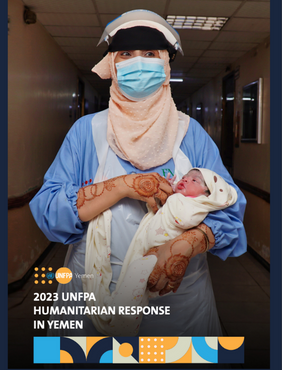
UNFPA Humanitarian Response in Yemen 2023
Yemen remains one of the world’s largest humanitarian crises. A staggering 21.6 million people require some form of humanitarian assistance in 2023, and 80 per cent of the country’s population struggles to access food, safe drinking water and adequate health services. These are the results of multiple overlapping emergencies that have pummeled the country: violent conflict, economic collapse, recurrent natural disasters and severely disrupted public services. Women and girls are bearing the brunt of the crisis. An estimated 80 per cent of the 4.5 million people displaced in Yemen are women and children. Approximately 26 per cent of displaced households are headed by women. Discriminatory societal attitudes towards women’s movement and economic and social engagement remain entrenched, and worsening existing inequalities and hindering women’s access to basic services. The ‘mahram’ (male guardian) requirement, increasingly imposed in northern parts of the country in 2022, whereby women must be accompanied by a male family member to travel, also applied to female national aid workers, not only restricts the ability of the humanitarian community to deliver life-saving assistance, particularly to women and girls but also serve to exacerbate women’s economic insecurity and access to health and protection services, with resulting repercussions for their physical and mental health. Access to basic rights and freedom of movement are even more challenging for women and girls who lack access to legal documentation due to discriminatory laws and procedures.

Whole of Syria Earthquake SitRep #4
Seventeen days have passed following the magnitude 7.8 earthquake that struck Syria and Türkiye on 6 February, impacting the governorates of Idlib, Aleppo, Lattakia, and Hama. Prior to the earthquake, 15.3 million people were estimated to be in need of humanitarian assistance throughout the country. On 20 February, a magnitude 6.3 earthquake struck the Turkey-Syria border region, resulting in additional destruction and causing further stress and anxiety to communities that have already suffered significant loss and trauma. These recurring earthquakes also underscore the severe vulnerability and risks in these hard-hit regions. While casualty figures are increasing every day, more than 5,900 fatalities were reported across Syria as of February 12, most of which (more than 4,500) have been registered in the country’s north-west. Over 11,000 injured persons have also been reported.
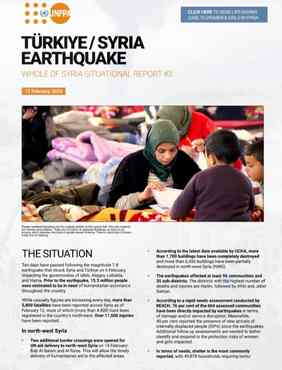
TÜRKIYE / SYRIA EARTHQUAKE WHOLE OF SYRIA SITUATIONAL REPORT #3
Ten days have passed following the magnitude 7.8 earthquake that struck Syria and Türkiye on 6 February, impacting the governorates of Idleb, Aleppo, Lattakia, and Hama. Prior to the earthquake, 15.3 million people were estimated to be in need of humanitarian assistance throughout the country. While casualty figures are increasing every day, more than 5,800 fatalities have been reported across Syria as of February 12, most of which (more than 4,400) have been registered in the country’s north-west. Over 11,000 injuries have been reported.
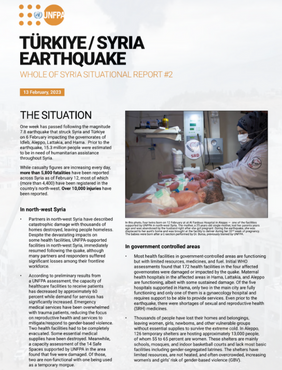
TÜRKIYE / SYRIA EARTHQUAKE - WHOLE OF SYRIA SITUATIONAL REPORT #2
One week has passed following the magnitude 7.8 earthquake that struck Syria and Türkiye on 6 February impacting the governorates of Idleb, Aleppo, Lattakia, and Hama. Prior to the earthquake, 15.3 million people were estimated to be in need of humanitarian assistance throughout Syria.
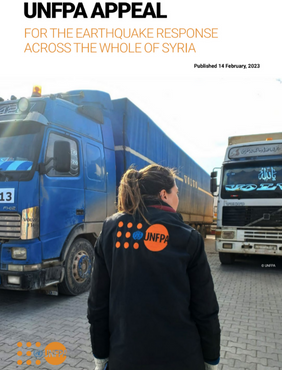
UNFPA APPEAL FOR THE EARTHQUAKE RESPONSE ACROSS THE WHOLE OF SYRIA
On 6 February, 2023, two major earthquakes with 7.8 and 7.6 magnitudes, respectively, hit areas of Türkiye and Syria, causing mass destruction of residential and public buildings, including hospitals, and significant loss of life. As of 9 February, more than 3,300 people have died and over 7,300 are injured — figures that are expected to increase significantly over the coming days as large numbers of people remain trapped under collapsed buildings. The full extent of the earthquake’s impact remains unclear, but the damage has been significant.
Idleb, Aleppo, Lattakia, and Hama governorates were severely impacted. Harsh weather conditions, including snowfall and freezing temperatures, have impeded emergency responses and the wellbeing of survivors. Lack of heavy machinery to remove rubble, especially in north-west Syria (NWS), has also complicated search and rescue efforts, and insufficient electricity and fuel have impacted services at hospitals and individuals’ ability to access health care and essential gender-based violence services. Damage to infrastructure has interrupted the delivery of basic social services including life-saving reproductive health services, putting the health and lives of pregnant women and their unborn babies as well as newborns at risk.
Women and girls, including pregnant and lactating women, are disproportionately affected by earthquakes and natural disasters, requiring tailored interventions to respond to their reproductive health needs and protection risks. As has been documented during assessments conducted by UNFPA throughout Syria, pre-existing vulnerabilities and inequalities affecting women and adolescent girls are expected to worsen, further exposing them to various forms of GBV. The disaster follows over a decade of crisis in Syria and compounds significant pre-existing humanitarian needs.
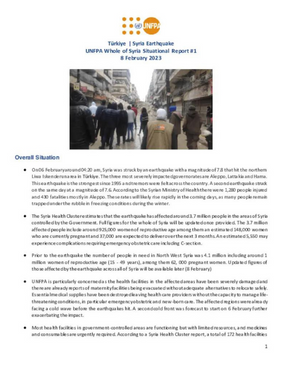
UNFPA Whole of Syria Situation Report #1: Türkiye-Syria Earthquake - 08 February 2023
The devastating earthquakes that struck Türkiye and Syria on 6 February claimed thousands of lives, damaged and destroyed buildings and infrastructure, and require an immediate humanitarian response.
In this first UNFPA situation report covering the whole of Syria, priorities are articulated for immediate response to reduce suffering and save lives as search and rescue operations continue. Across Syria, UNFPA is focused on providing essential psychosocial and GBV response services across all affected areas, and providing basic reproductive health services to meet the urgent needs through mobile health teams and static clinics.
There is an immediate need for psychological first aid and ongoing needs for the provision of psychosocial support, and if possible, referral for mental health services for those requiring more specialised services given the traumatic experiences. Essential needs for the immediate response include: reproductive health medical supplies, menstrual hygiene materials, winterised dignity kits, blankets, newborn items, winter clothing, tents and / or prefabricated structures to provide lifesaving SRH and GBV services. Fuel is also urgently needed to ensure continuation of critical service provision, particularly in health facilities.
Coordination and functioning referral systems are being scaled-up so that transit and reception areas for displaced persons can mitigate the risk of gender based violence. Humanitarian assistance also needs to ensure affected populations are protected against the risk of sexual exploitation and abuse as people are extremely vulnerable.
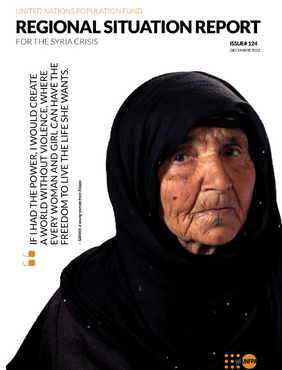
UNFPA Regional Situation Report For the Syria Crisis — December 2022
As the year 2022 comes to an end, Syrians and host communities throughout the region prepare for another difficult year. People in need continue to face the escalating impact of a protracted humanitarian crisis, further complicated by a deteriorating economy, continuing hostilities, and chronic and emerging health threats, including an unrelenting pandemic and a worsening cholera outbreak. The crisis region, which spans the Whole of Syria, Türkiye, Lebanon, Jordan, Iraq, and Egypt, continues to face a multitude of challenges, particularly in light of the recurrent waves of COVID-19 infections that continue to exacerbate existing needs. A decade into this protracted crisis, people in need continue to endure the cumulative effects of years of instability, the risks of which are even higher now due to the ramifications of a far- reaching economic meltdown. The Regional Situation Report for the Syria Crisis offers a bird’s eye view of UNFPA’s operations within the context of the Syria crisis. The report is prepared by the UNFPA Regional Humanitarian Hub for Syria and the Arab States in Amman, Jordan, and spans operations conducted by UNFPA offices in Türkiye, Lebanon, Jordan, Iraq, and Egypt, in addition to operations conducted inside Syria from Damascus and cross-border via Türkiye.
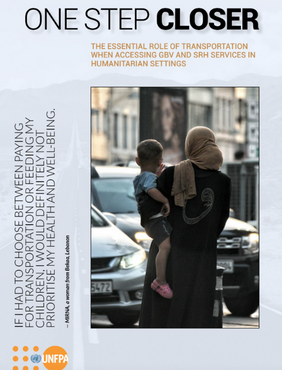
One Step Closer - One Step Closer The essential role of transportation when accessing GBV and SRH services in humanitarian settings
UNFPA’s programme data and assessments show that women and girls consistently identify transportation as one of the first barriers when it comes to accessing health facilities and Women and Girls Safe Spaces in humanitarian settings across Iraq, Jordan, Lebanon, Syria, Yemen, Sudan, and Türkiye. It is well documented that women and girls are often exposed to safety and security risks while commuting, including when trying to access humanitarian assistance such as GBV or SRH services, during which time they may be exposed to sexual or other forms of harassment, physical abuse, or other types of GBV. As one adolescent girl from Ar-Raqqa explains, “we feel less safe than before. When we leave our homes, we are afraid of harassment, rape, and kidnapping.”
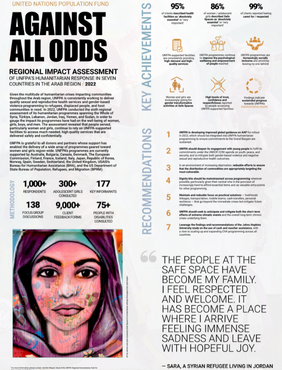
Against All Odds: Impact Assessment of UNFPA’s Humanitarian Response in the Arab Region
Given the multitude of humanitarian crises impacting communities throughout the Arab region, UNFPA is consistently working to deliver quality sexual and reproductive health services and gender-based violence programming to refugees, displaced people, and host communities in need.
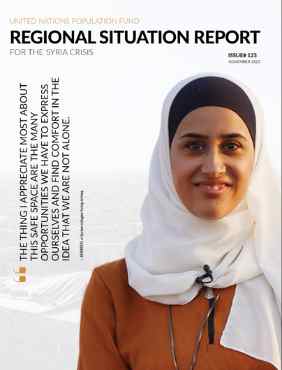
UNFPA Regional Situation Report For the Syria Crisis — November 2022
As the year 2022 nears its end, both Syrians and host communities throughout the region continue to face the escalating impact of a protracted humanitarian crisis, further complicated by mounting region-wide inflation, continuing hostilities, and chronic and emerging health threats, including an unrelenting pandemic and a worsening cholera outbreak. The crisis region, which spans the Whole of Syria, Türkiye, Lebanon, Jordan, Iraq, and Egypt, continues to face a multitude of challenges, particularly in light of far- reaching economic crises that continue to exacerbate existing needs. A decade into this protracted crisis, people in need continue to endure the cumulative effects of years of instability, the risks of which are even higher now due to the impacts of a far-reaching economic meltdown. The Regional Situation Report for the Syria Crisis offers a bird’s eye view of UNFPA’s operations within the context of the Syria crisis. The report is prepared by the UNFPA Regional Humanitarian Hub for Syria and the Arab States in Amman, Jordan, and spans operations conducted by UNFPA offices in Türkiye, Lebanon, Jordan, Iraq, and Egypt, in addition to operations conducted inside Syria from Damascus and cross-border via Türkiye.